pdf: shopping – who gives a toss
docx: shopping – who gives a toss
Safeways burning during the Watts riot of 1965
This text was written by me and distributed at the beginning of 1998 in Hornsey, North London, in an area where a regeneration project was being proposed by the council, a project which directly threatened my quality of life, since I was living 100 metres from the supermarket area to be developed. After a couple of years or so, the supermarket aspect of the project was abandoned, though it’s impossible to say whether the distribution of this text played a small part in the abandonment or not (probably not). It is followed by a text on looting and shops produced as part of the text “Miner Conflicts – Major Contradictions” in July 1984.
but
WHO GIVES A TOSS?
…WE DO!!!
An altered version of the plans presented by the council
Only those in the area in a deep coma will not have heard about the redevelopment on the Council Depot/Waterworks site on Hornsey High St. which Sainsbury’s and Thames Water are so kindly imposing on us. Sainsbury’s (one of Tory Blair’s and Haringey Councils’ billionaire friends) are planning a 40,000 sq.ft. megastore, MacDonalds may be moving into the Pump House and there’ll be a 163 unit high-density residential development along the New River. Along with the proposed redevelopments up to Wood Green, the whole thing could take up to 7 years before it’s finished.
We know what all this means: the area will become a dust-filled, pollution-filled, juggernaut-filled, noise-filled building site. And on completion it’ll mean 3500 extra car journeys minimum along the High St., a possible road-widening programme to cope with it, and so a big leap in exhaust fumes and lead poisoning. Joy for our kids! All this to make the bore of shopping easier! And yet the consequent closing down of most non-specialist food shops and newsagents within a 1 mile radius will mean that those not within a 300 yard radius of the new store will have to travel further for their non-bulk food shopping than they’re doing now. Oh, well!
All this is being hyped up by the council spin-doctors, experts in slick bullshit: “The programme’s mission is to enhance the vitality and the local economy…making it a more attractive place in which to live, work, visit and invest. Underlying this is the aim of making a significant reduction in the relatively high levels of local unemployment blah blah blah”, says the council. The original spin-doctor, Dr. Goebells, Hitlers’ Minister of Propaganda, would have turned green with envy. They say they’ve got a mission. Like all missionaries, the council hope to manipulate us, the colonised, with an ideology of deferrence to the lies of the colonisers – but it’s less “Praise the Lord!”, more “Praise Lord Sainsbury!”. These hypes are so banal that few even notice them, let alone believe them. We’re so used to ideology and lies that most of us react with cynical indifference. Certainly to be outraged is hardly worth it. Most know that it’ll be as “vitality”-enhancing and “attractive” as all our other experiences of being shitted on from a great height. Most know that Business couldn’t care less about making a place “attractive to live”. For Business “life” is where there’s a big crowd of Big Spenders – about as lively as the tube at rush hour.“Attractive…to visit”? – only if they visit the long queues to the till with trolleys stacked high with enticing attractively packaged goods whose consumption at home never lives up to the promise of their image. They leave you full maybe, but somehow empty. So it goes.
What they really mean by making it “attractive” to work and invest in is to make the labour cheap enough to attract the multinationals. We are all meant to cheer everytime we hear how a job has been “created”. So let’s all cheer Sainsbury’s participation in Tony B.Liar’s Welfare to Work programme: it’ll mean making a job ‘attractive’ to the young people selling their labour by threatening them with starvation (hip hip hooray!). Besides, the closure of factories on the site, coupled with the closure of shops should the development go through, will mean a net loss of jobs. Which is no surprise to those who have realised that the whole Welfare to Work plan is not so much about increasing jobs but is aimed at massively cutting wages and conditions everywhere.
A few months back Sainsbury’s & Thames Water provided a 2 day exhibition along Hornsey High St., complete with full colour brochures trying to make you feel like you’d want to spend your summer holidays in the sunny aisles loading up with 57 varieties of extra virgin olive oil. They generously claimed to be bringing “life back to your Town centre”, as if life equals big business, when it’s obvious that life can only be affirmed by opposing its humiliating suffocation by busineness. Everywhere, the glossy image of life is represented to console us for its repression in reality. Everywhere a bad situation (in this case, the lack of liveliness on the High St.) is used to justify making things worse.
This brochure can claim “There will obviously be some increased traffic…but at the worst time this amounts to an extra 3 vehicles in each direction per minute.” In fact, it’ll mean an extra 3500 car journeys a day. This is according to the council’s own calculations ~ which, considering they support the plan because it’ll help towards paying off the Ally Pally debt, are probably an underestimate. Translated, this means 3 extra vehicles in each direction over 19 hours in 24, not just “at the worst time”. In reality, of course, most of the extra will take place within a far shorter period of time than 19 hours. One can only assume that such magical statistics are used to reassure only those who daren’t think for themselves. Yet another fairy tale as convincing as the government’s “Trust us”. And we shall all live happily ever after.
The result of any successful “regeneration” programme will obviously be degeneration: fumes, dust, the boarding up of shops, etc. aren’t just miserable in themselves; people withdraw more into themselves, the streets become a lot more alien than they are and everyone feels more useless than they already do. It’ll mean, bit by bit, a decay in the positive aspects of the, admittedly superficial, friendly side of the village feel of the area. Anyway, “community” is a buzzword meaning very little nowadays outside the self-interested business ‘community’ (largely a mutually contemptous ‘community’, riven by rivalries, but coming together not out of reciprocal interest in each other as individuals but out of narrow, and often very short-lived, economic interest). It is the absence of any real community in our lives that allows us to endure the artificial representation of community, whether it comes from politicians, Big Business or TV soap operas; and real community can only develop in struggle against such representation.
Real community is a lot more complicated than all those who spout the word with as much reflection as a matt black wall. In fact, the desire for community is far greater than the reality. The old geographically-based working class communities, where there was a common antagonism towards ‘Them’ and a common trust, have been severely weakened: what the development of traffic and gentrification hasn’t wrecked, the culture of seeking security and comfort indoors – on top of the big differences in workers’ incomes – is helping to finish off. In this country, where common struggle against the powers-that-be has been enormously repressed, people tend to not only shut out any new friendships: with already existing friendships, often any petty disagreement flares up out of all proportion,becoming not only a reason to cut off, but increasingly a reason for a punch-up. Compared with, say, poor Third World countries, where there’s often an enthusiasm towards strangers and a great desire to socialise, here people are more and more cut off & in retreat (sure, there’s a down side to these old-style communities of the poor: for example, they can be particularly repressive and suffocating for women when it comes to any desire for sexual freedom). At the same time, anyone with a critical rebellious frame of mind often feels they have to keep their heads down for fear of unwillingly antagonising the neighbours: superficial friendliness is better than no friendliness at all. And those at the sharp end, often having to survive in the black economy, feel – in these days when the State encourages resentful people to grass up their neighbours – too paranoid to even talk about their work or where they get their money from. And all this is called ‘community’: better than nothing, but hardly worthy of the name.
Undoubtedly, in periods where people collectively oppose some common misery – like we did with Poll Tax 8 years ago (it seems more like 80, the way things are) the sense of community is far greater than when it’s everyone for themselves.
So far there has been no independent working class opposition to this scheme, the only apparent opposition coming from the middle class dominated organisation HIPE. At public meetings on June 10th and Dec.lst, 1997, HIPE showed how organised and clued in they were. But amongst the more lucid observers several reservations began to emerge.
Firstly, they claim to be a ‘non-hierarchical’ group. But like most middle class resident-type associations, they use the buzzword ‘non-hierarchical’ like an advertising slogan, to appear credible and correct, to draw people in with an image of openness. Yet the way they conducted their meetings belied the ‘non-hierarchical’ sales technique. The meetings were laid out as raised platform and lowly punters. At the June ‘97 meeting the microphone was used exclusively by the steering group and the representatives of the Council and groups like Friends of the Earth approved by them (incidentally, in the 80s, under Thatcher, FoE connived with Sainsbury’s use of the governments’ notorious Youth ‘training’ Schemes, ie. super-exploitation of the young). At both meetings points from the floor were ruthlessly disciplined; most notably, at the December ‘97 meeting a guy who opposed the redevelopment totally (as opposed to HIPE who keep telling people that a 16,000 sq.ft. supermarket is fine) was interrupted after 2 minutes and told he was talking for too long (those on the platform spoke for 5 minutes minimum). This at a meeting where a clear majority opposed any supermarket on the site. Nothing of this is ever mentioned in HIPE propaganda – surprise, surprise – which continues to push for a smallish supermarket.
In private one HIPE member said they’d be prepared to accept a 25,000 sq.ft. supermarket (a lot bigger than Budgen’s at Crouch End) and that Sainsbury’s may come down to 27,000 sq. ft. So HlPE seem to be creating Much Ado About virtually Nothing. Maybe this’ll be the eventual compromise, hailed as a “victory for commonsense” on all sides. HIPE is probably a valuable tool in the development process, allowing the council and the developers to foresee any element of their scheme that might genuinely alienate local feeling and arousing an intense sense of anticipation without having to go to the expense of putting up billboards (it’s not for nothing that Haringey Council’s silent Town Planner sat quietly taking notes at the Dec.lst meeting). Consciously or not, HIPE act as a mediation between local residents, the council and the multinationals; they are a sounding board for dissent, helping the developers neutralise opposition and incorporate it into its verbiage, dressing up their essentially irreversible decision in a language that appears to take in people’s concerns. At HIPE’s Dec.lst public meeting much of the opening statements were devoted to HIPE congratulating themselves on how much hardwork they’d put into responding to the plan. Undoubtedly they have, so let’s give them their due: they’ve informed local people of the implications of the project by providing them with the precise statistics and information concerning it all. Nevertheless, one suspects that all this patting themselves on the back was aimed at shutting up anybody who might question their perspectives and proposals, make them feel guilty for not putting in the same degree of effort. Really all HIPE has done is give more precisely researched details to what anybody with half a brain had realised as soon as they’d heard of the plans. The middle class tend to exaggerate such expert knowledge because it makes their specialism seem indispensable. But authorities aren’t disinterested ‘rational’ people solely convinced by facts: what matters to them is money & power and the ability to manipulate people into submission. Strikes, occupations, riots, social contestation – and the ideas that arm such anger – are what worries them, not endless letters and petitions
It’s significant that people in HIPE see a Public Enquiry as the be-all-and-end-all of their campaign. If a public enquiry is lost then they’ll give up the ghost. All this letter-writing etc. leaves the so-called community consisting of everyone stuck at home in isolation. Letters might sometimes be o.k., but when people are virtually told what and how to write by the experts in HIPE it drains such letters of all self-expression; a polite correspondence with the authorities who humiliate us only reinforces their contempt for us. HIPE can only see things in the most passive terms – for instance, not voting Labour in the council elections, as if a cross every few years ever meant a change of anything other than suits. Someone from HIPE at one time said they’d thought of blocking the traffic along the High St., but when someone said, “Oh, like a Reclaim-the-Streets-type festival?” she backed off – nothing so naughty, so daring. “No, no – just to show people what the build up of traffic would be like if the scheme went through!”. That’s why their march to the Council Town Planning dept. was advertised not as a demonstration, but as a “walk”. 9 times out of 10 a demo is largely a symbolic gesture, a routine moralistic ritual. But in these crass times, even the term “demonstration” could frighten off the nice neighbours: a “walk” is so much more innocuous. Endlessly demonstrating their impeccable respectability is the only demonstration for them.
Behind the rhetoric, HIPE’s main concern, we suspect, is that such a redevelopment will bring down the values of their properties. Significantly, some of those in HIPE were involved, not so long ago, in a successful campaign to stop the conversion of a local house into a hostel for the homeless. “Can’t have them bring down the tone of the neighbourhood” (read: “the value of my property”). The majority of people affected by the site, however, don’t own where they live: they’re either in absurdly expensive and insecure short-term tenancies or they’re in council or Housing Association flats. The worsening air and noise pollution is going to effect many more working class residents than middle class because the closer to the site, and to the site’s access points, the more working class the residents tend to be (we stress that this a tendency: obviously there will also be many middle class people directly effected). Since a fall in property prices presents no problem to the poorer residents, this is the one concern that is only ever mentioned in private. HIPE are presented to the poorer majority as the Great White Hope: being mainly middle class they’ve got more time and resources (and tend to be less stressed) to organise an apparent opposition to the scheme. At the same time, since Poll Tax, there has been virtually no mass independent working class movement against the ever repressive market system and the State that manages it in this crap country; the poor have not acted as a class for itself, deferring to the experts for want of a self-confidence that can only come from acting for themselves. Thus, even the working class minority in or around HIPE who are opposed to any supermarket (some preferring the development of a massive kids’ area on the site) have deferred to the more “articulate” middle class majority.
Apart from property prices, HIPE’s main concern is the effect on small businesses. Many of these businesses are opposed to a superstore, which will reduce trade for food and drink shops by about 20% as far away as Crouch End. So it’ll have a knock-on effect on all the small shops since closed businesses bring down the tone of the area as well as the number of shoppers generally. But most would support a 16000 sq.ft. store, because it’ll draw business their way.
Though we have no desire to see loads of boarded up buildings, the war between Big and small business is no more our concern than any fight Labour may have with the Liberal Democrats or between the two sides in a war between big and small nations. A boss is a boss is a boss.
After all, Sainsbury started small. Small is not necessarily beautiful: it’s not size but what you do with it that counts. Sure, lots of small shops tend to make an area a bit friendlier and less anonymous than ones where big stores dominate. Generally speaking, you can talk to a small shopkeeper far more easily than a harassed check-out assistant. On the other hand, the pay for wage-slaves in small shops tends to be lower than that in supermarkets, and the cost of the goods tends to be higher, though this is sometimes mitigated by the fact that regulars may get a bit of a reduction in the cost and may get goods on tick. And small shops tend to treat shoplifters better than the big stores – they’re a lot less inclined to call the cops if they catch you – I’ve even seen a shopkeeper in the area letting a poor woman nick a can of beer, just telling her not to do it again, whilst letting her keep it – impossible in a supermarket. What’s more, a lot of small shopkeepers have been forced into self-employment by this shit system, and, were there to be a movement against it, some would possibly support it. However, because of their social relations – most of them being small-time employers paying a pittance to a wage-slave – they can never imagine things beyond the mad abstract rules of this society – commodity exchange, buying and selling etc. For them a small supermarket in the area poses no problem: they’re not especially concerned about the extra fumes, noise and danger to their kids – all they’re mostly bothered with is the chance of extra punters and profits for their business, That’s one extra reason why an uprising involving mass looting has rarely spared the small shops, even if the big stores offered the richer pickings. Indeed, only a movement on the scale of 1981’s burning’ ‘n’ a lootin’ of the supermarkets, when £300 cameras were used as missiles against the police at Wood Green, could really reverse this development. The irony is that, with so many other miseries to contend with, few people, other than maybe a local grocer frightened of his business collapsing, could work up the energy to take the risk of setting the night on fire over such a project, And it’s unlikely, under the present reign of money terror, that looted cameras would end up as missiles; they’d more likely end up in car boot sales nowadays, at a third of their shop price.
In July 1981 Wood Green erupted into riot. Supermarkets were looted. £300 video cameras were thrown at the cops. It was bliss to be alive. But now? Many people think of riots as a bunch of psychotics attacking indiscriminately. Undoubtedly, some people in riots do behave crazily, but then they behave crazily outside of riots also. The media obviously pick up on such incidents to tar all rioters with the same brush, and thus frighten off anyone potentially sympathetic to the anger that livens up the High St. Nevertheless, in the anti-economic riots of ’81, there was infinitely more friendliness than there is in the quiet passivity that reigns today. Nowadays, working class violence to working class people is far worse because the normality of alienation and isolation is far more intense. In ’81, the feeling of a beginning of a movement against the futureless world we live in broke down the barriers between working class people. The media, as servants of the State and propagators of the market, obviously prefer hierarchically organised violence – such as war or, less obviously, the 1000s of pensioners who die each winter because of expensive heating bills.
Recently loads of pro-Sainsbury posters have appeared in non-food shops in the area (if Sainsbury’s didn’t sell food, the grocers would have done the same). Never mind the escalation in pollution-induced asthma attacks in kids – after all, the shopkeepers who are parents hope to be so raking it in that they’ll be able to move as far away from the high fume area as possible. They know the price of everything and the value of nothing. This is the upside down logic of this upside down world which, above all else, produces the need for money. And the logic of this need is hell-bent on destroying the world. Shopkeepers cheer Sainsbury’s; farmers and butchers cheer British beef; heroin dealers cheer the poppy industry; arms dealers support war, etc.etc. However, there are some naive people in the area who have no money interest in the matter who are conned by the glossy image of a Brave New High St. Half-dead in the present some of us somehow imagine that lots of people will somehow give them life. They’ve probably never been to Oxford Street round Christmas (aaaaagh!!). Let’s face it, who feels lively when they’re doing their household shopping? As for the other shopping, it’s a drug with a very short-term high, leaving you desperate for another hit. The reality of the hypermarket in 2, 4 years time or whatever obviously won’t live up to any naive expectations. But by that time the authorities will have thought up another Final Solution to decay. The carrot of a better tomorrow will just be updated, that’s all, For those who hope for a future determined by anybody but themselves and by mass struggle, tomorrow is a mirage in the desert which vanishes as soon as you approach it, leaving you with a desperate thirst for refreshment.
 An artist’s impression of Hornsey High Street as it would look after the new regeneration development.
An artist’s impression of Hornsey High Street as it would look after the new regeneration development.
HSG is giving out this text not out of any desire to substitute ourselves for you and your friends ideas and initiatives: we’re not a vanguard. We cannot offer some illusion of hope, like HIPE or the political parties. However, we’d like to see some movement against this misery because it effects us, which is why we’d like to meet up with some people who have some ideas about the situation and what to do. Even if we don’t get this ‘regeneration’ project stopped, what matters is that we try and in so doing, make new friends, develop some confidence and get some discussions going about what to do against the other humiliations that are hitting us from all sides. Against the usual “There’s nothing we can do”-type syndrome, weve got to start somewhere to say “Enough!”. How else can we help towards some movement that’ll make us feel dignified and begin to combat this restless deep anxiety about the future we often have, these feelings of some crazy nightmare descending on us…?
This text, as a whole, expresses the views of a minority of people within HSG. HSG has no party line. The majority of HSG, whatever our diverse differences with this or that opinion expressed here, believe it is useful as a springboard for discussion, and possible action.
 An artist’s impression of most readers’ response to this pamphlet
An artist’s impression of most readers’ response to this pamphlet
If some of this text seems hard to understand, it’s mainly a reflection of how little people try and want to understand. Every word here is part of daily language. It’s a question of whether the reader is prepared to make as much effort to understand as the writers made in trying to make sense of confused reality. Likewise, the readers, insofar as they want to unravel what’s in front of them, have to make the same effort, in communication with others.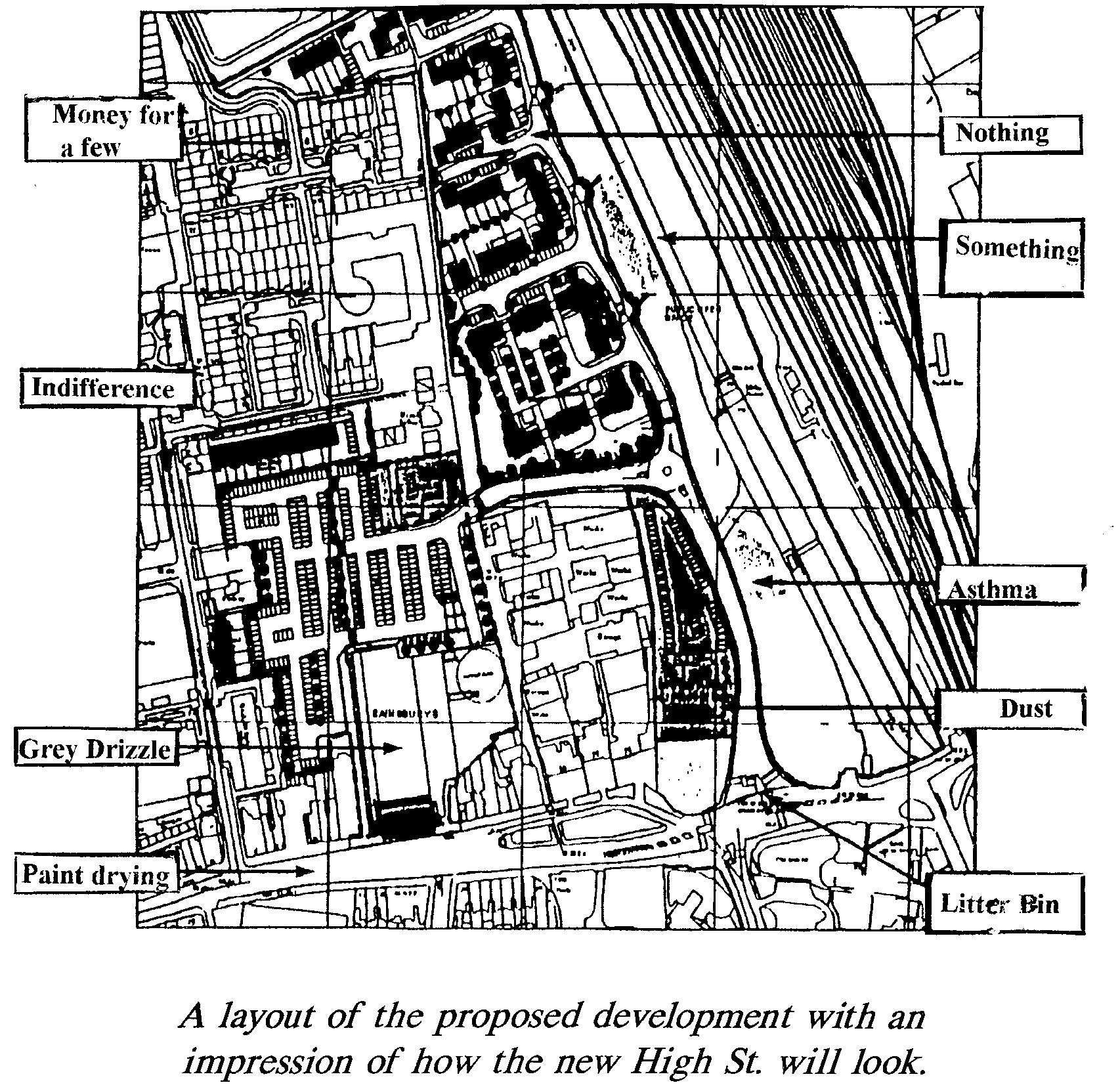 Back page of original pamphlet
Back page of original pamphlet
This and the other “maps” are altered versions of the official council ‘map’ of the planned ‘regenerated’ area, also entitled “A layout of the proposed development with an impression of how the new High Street will look”
SamFanto note:
In fact, HSG (Haringey Solidarity Group) refused to give this out, despite pretending that they would: so much for ‘solidarity’. See this text about HSG.
The following text, about looting during the riots of 1981 and other aspects of shops, was the last part of “Miner Conflicts – Major Contradictions” but we felt it was appropriate here (it was preceded by a photo of workers looting a state-owned store in Gdansk, Poland, December 1970).
“Shopping should be an emotional experience. People should want to drop in.” –
Mr.Quayle, director at Woolworths’ “21st Century Shopping Ltd.”, new name for Woolies in Bristol (The Times, 14/2/82).
“Just doing a bit of window shopping” –
Wood Green rioter, 1981 (LBC, July ).
There are certain situations when dropping into a shop is a truly emotional experience. That’s when people start to smash that blatantly seductive parader of the beauty of possessions, the shop window which reflects back to you the ugliness of your fundamental dispossession. Don’t the vast majority dream of wrecking that fragile separation? At the same time as it titillates us with things we’ve been told we want, it prevents us from grasping them. When we smash a shop window, it’s not only the miraculous display of things (with their artistic image association and their ideological free gifts) that gets shattered, but also the ‘reasonable’ cops in our head. The objects become what they always were – just objects, whilst the bourgeois rationale that hypocritically distinguishes between theft and property also appears for what it is: bullshit to keep us impotently yearning. How can those who resign themselves to a world which is meant to be expectantly gazed at know the simple beauty of the delightful anger hurling the brick shattering the repressive splits of this fragmented vicarious life? Perhaps they mutter “Greed…Resentment” as they greedily clutch onto their narrow resentment of those who are having a smashing time. One guy during the riot days of ’81 smashed every window in Barkers on his own – and never tried to even take anything. Often people smashed shop windows in order to nick nothing more than what they could far more easily steal from Woolworth’s on a crowded shopping day with little risk. And the greedy slander this contempt for the law and order of things as ‘greed’. When stolen cameras were used as missiles (Wood Green) and TVs were dropped onto the heads of cops (Liverpool), it was the Holy Trinity of the Commodity, the Media & the State which were being wrecked. When a thirsty kid in Brixton swapped some jewellery for a can of cold coke, exchange value was being subverted by the value of desire. Yet still ‘socially aware’ pedagogues could smugly moralise about ‘greed’ along with the Daily Mirror and the rest of the capitalist media. Greed had fuck-all to do with it – and only “socialist” specialists, and other politicians, had a material interest in belittling the looting to this lowest common denominator.
It is the game of dare that shatters the vulnerable veil separating the dispossessed from the “wealth” this world has to offer, at the same time shattering the ideology of exchange that separates people from each other; looting is a collective activity that unites us on the basis of an immediate break with our habitual submission to space & things. In those July days, youths often stole things in order to give them away as presents to attractive strangers who, by means of such give and take, were no longer so strange. But shopping keeps us apart, making everyone the policeman of their own encounters, reducing everyone to the banality of shop assistants arid customers, workers and consumers, enervating queues and digits on a till. Products of competing businesses and the separation of production from distribution, shops perpetuate the nonsensical degrading form of organising things, the commodity form, which not only insults everyone’s imagination and dignity, but is also bureaucratic, inefficient and wasteful. Any proletarian with an ounce of audacity rightly goes out and liberates them on the basic class recognition of a simple re-distribution of wealth. But it would be merely ideological cheer-leading to sociologically ‘justify’ looting in terms, say, of bridging the gap between the haves and have-nots. Such moralistic reformists want to turn looting into a struggle for equality under the law of exchange, and thus usually reduce the explanation for looting as being to do with unemployment, and only unemployment. That way looting can become ‘safe’ and not really the concern of those workers who are a bit higher up the commodity’s ladder than the unemployed. “Understandable, but inexcusable”, as Claire Doyle from the Militant Tendency condescendingly put it. The Right, since they had no reason to express any sympathy for the rioters, were usually a bit more sussed. Breakfast TVs’ fuehrer, Tory M.P. Jonathan Aitken, complained about what “took place in the prosperous and peaceful towns of Maidstone and Tunbridge Wells”, where “hundreds of teenagers ran amok in the streets” and “petrol bombs were thrown and a number of shop windows were smashed.” Choosing his words carefully, he stated, “I do not think that any objective observer could see there any of the symptoms of decay, deprivation and degradation that we have heard so much about in inner cities in other parts of the country.” Of course, it’s never “objective observers” who experience the prosperous passivity of sweet English towns as symptomatic of the decay of their desires ,the deprivation of their intelligence and the degradation of their humanity: only subjective participants can experience that. Meanwhile, specialists in ‘objectivity’ content themselves with teaching the masses. “Youth is a force which can be used for the destruction of society, or for the re-building of society. That is what the House and the Nation should be about. That is what our leaderships should be about, on both sides of the House. The art of politics is to change the negative or destructive to the positive. The young should be turned to a proper purpose that will benefit us all.”, said Sir Hugh Fraser, Tory M.P. (of course, the art of attacking politics is to try to make sure that the negative or destructive don’t get changed into “positive” forces [like the Falklands War?] whose proper purpose is to turn the intimidation of youth into a profitable unit which would be of benefit to the leadership of commodity society ). Didactic arrogance is not, however, the prerogative of the Right. Leftist SWP leader, Tony Cliff, said at a meeting in Liverpool at the time, “Because they have not been organised the kids have been attacking shops when they should have been attacking factories. We must teach them to take the bakery and not just the bread”. The Left, left behind by a movement of kids who were teaching their parents, had to pretend they knew it all as usual, and that the kids were too thick to make the revolution according to their blueprints. Again the Right were a bit clearer: “The French revolutionaries were most interested in securing bread; they were asked to eat cake, but they wanted bread. They are surely strange revolutionaries in our streets today, whose first motivation is to steal the products of a capitalist consumer society. I do not see those people as the traditional vanguards of the proletariat. I see them as people who have…rather less of a need for bread. ” (John Butcher, M.P.).
Then there are those urban reformers who were really frightened by the extent to which urban dereliction contributed to the trashing and burning of those nice little shops in poor neighbourhoods, the “horrific” consequences of high rise estates, desolate spaces, barren streets After all, such conditions destroy that convenient informal network of vigilance and surveillance which, including authority figures such as teachers, parents, shopkeepers, local businessmen, publicans, etc., made the job of the cops a fuck of a lot easier: one way or another people were always ‘known’ to each other. But increasing anonymity has meant that the local shop could be done in without much risk of being made to pay the cost. Behind the veil of good intentions there’s that inherent class bias in which small business interests come first in their apparently damning indictments of urban development. They just want to try to recreate the conditions which they pretend once bound otherwise class-divided ‘communities’ together. That’s why they tend to sensationalise street crime. But their greatest fear is the kind of explosion of class war which has no compunction about attacking small businesses, which is exactly what happened on Britain’s streets between July 4th and 13th, 1981. In response, one M.P. suggested that “…corporations might engage in marketing studies… They might suggest to neighbourhood retailers how they could make the shopping precinct more attractive, and they might wish to get involved in giving the area a facelift… improve, say, the appearance of the shop frontage.” (Anthony Steen, July 16th 1981 ). Doesn’t this show the poverty of all aestheticised architecture? It’s all just fancy icing coating the rotten cake of market relations, the appearance of an attractive facelift hiding the contempt of the commodity.
The basic disgust youth developed then for the petit-bourgeois mediocrity of shopkeepers was also disgust for the polite policing which is encouraged not only by the reformers but also by the dominant class (after all, Thatcher’s father was a grocer ). This disgust often transcended racial considerations also. For instance, the same Asian shopkeepers who had a ‘sympathetic’ meeting with Thatcher in Southall after the white fascist attacks on their shops, got smashed up a week later by Asian kids. Those who identify with their present means of survival, always always side with the perpetuators of their misery in the end, regardless of their colour – and black and white youth are beginning to recognise it. It’s not too difficult to see that behind the shopkeepers’ “May I be of any assistance sir?”, behind the “Thank you” and “Please” and the occasional smile, lurk petty-minded shrivelled little tyrants,who think they’re free because they’re ‘their own boss’, content with their island of illusory dictatorship, where power is reduced to short-changing. Regardless of their longing for some fantasised former simplicity and local autonomy, regardless of the fact that, like Covent Gardens’ “Alternative Bookshop”, they might call themselves anarchists and certainly moan about central government, they almost invariably call the cops. Such dreary respect for the graveyard of the present was smashed with every stone thrown. Until the proletariat seizes and transforms the economy, pillage will always be the minimum expression of life.
Looting implies mass communal direct power, unmediated by buying & selling, by cops & specialists: it is the necessary ‘chaos’ through which we must pass in order to organise the distribution of things on a rational and playful human basis. Theft, particularly mass theft, gives you the chance to re-invent the use of a thing beyond the resigned individuals’ normal submission to the insult of its market value the use to which the Economy demands the individual sacrifice himself to, for which degrading irrationality all the Property Laws are the tedious justification. Against this complicated normality, the rioters have shown the abnormal simplicity of a creative use of space and time. In Keswick, bikers smashed up the theatre, getting away with some of the costumes. In Manchester we saw something a little better than the ultra-leftists’ wet dream of a Free Transport System when rioters stole milk floats and concrete mixers to attack the cops. In Brixton, space invaders machines from ‘Space City’ were used as barricades against the real space invaders – the cops and the traffic, a neat way of showing how the idiocy of the leisure spectacle can easily be turned against the perpetuators of this idiocy. A whining Sunday Mirror hack wrote that whilst standing outside a smashed half-looted clothes shop, a young woman came up to him and said, “May I be of any assistance, sir? I’m sure we can find something your size. And if we can’t find anything today, I’m certain we’ll have something in stock tomorrow.” Here, humour, normally unserious, safely separate, compensatory and evasive, re-discovered it’s point – sharpened, this time, by life, by reality: here, unlike in The Young Ones, The Comic Strip or the rest of the Alternative Decomposition crew, the juxtaposition of incongruities was used to directly challenge the irrationality of the present. Not only was nothing pre-scripted, but the old scripts were spontaneously turned upside down. The parody of politeness, armed by the practical situation of mass subversion, reveals the miserable stupidity of the complicity of individuals with the roles the division of labour demands of them. No wonder the Sunday Mirror mercenary moaned about how bizarre It all was: jokes ain’t wot they used to be.
Some “revolutionaries” complained that the kids at Finsbury Park looted gold in order to re-sell it. To them it’s an expression of class solidarity when workers go on wildcat strike for a wage rise, but when marginals riot and also get what amounts to a wage rise, these workerists become purists and put down this expropriation as perpetuating commodity relations. Nevertheless, it’s possible that one day survivalism and its “compensations” will be superseded to such an extent that gold bars will end up like the £300 cameras in Wood Green: as ammunition – their only use value. Until then, the theft of gold for re-selling merely shocks the dominant class because it mirrors the contradictory irrationalities of the market economy the dominant class is based on. Theft, like hustling, may be necessary but hardly sufficient: such acts assert the self-direction of the masses against the tyrannical misery of the Commodity on one level, yet on another level undermines this practical position by perpetuating its’ rules, expressing the decomposition of the system and its’ values without in itself posing an exit. Obviously whilst this world is not opposed by an explicitly intelligent global confrontation, posing practically the supersession of the commodity economy, it would be self-defeating to lob the gold at our enemies. Until global anger has carried us that far, the necessity of determining our existence will inevitably be riddled with the subtle contradictions of The Market. Until then, theft is necessary: but pumping it up or putting it down are just different ways of pumping oneself up or of putting oneself down, stopping a more profound questioning. Until we truly do go over “the edge of the abyss, beyond which lay anarchy, the breakdown of law and social catastrophe” (The Guardian, referring to the riots) quite a few more questions are going to have to be posed and answered.
Gdansk – looting of furs etc. during the uprising in Poland in 1970
*****
For an interesting account of a strike in the supermarket sector see Break Their Haughty Power (Loren Goldner’s website: http://home.earthlink.net/~lrgoldner/supermarket.html) on the American supermarket strikes at Safeway, 2003 – 2004.
PS
At the end of August 2011, I posted this on Libcom Blog under this article:
The latest Private Eye reports a riot in Hornsey High Street, the subject of this text:
Quote:
Riot poice took until 5am to restore order as around 200 youths aged between 14 and 20 rampaged along Hornsey High Street. Police vehicles were damaged, people were arrested for violent disorder and one bar was stripped of its licence after the incident. Police Sergeant Michael Tisi told the local paper that even after he was joined by several marked police units: “I felt it was not safe for officers to intervene as we were massively outnumbered”
The Tottenham and Wood Green Journal wrote:
Quote:
Youths armed with glass bottles, bricks and stones turned a high street into a warzone
This did NOT happen just 2 weeks ago, but back on March 12th. Neither the dominant media nor Haringey Solidarity Group, afaik, covered this significant riot.
Small A4 sized poster, mid- 1970s
sticker, mid-1970s
The following is taken from the movement in France against the extension of the age of retirement in the autumn 2010:
Proletarian shopping precincts
On the night of 23rd – 24th October arson completely destroyed a small shopping precinct, employing 50 people, in St.Etienne du Rouvray, near Rouen. No-one was hurt.
On the day of the last General Strike, Tuesday 19th October, a small section of the main demonstration split off from the rest and went along to the main shopping precinct, the Polygone, possibly inspired by the examples of Rennes, where a few weeks back about 200 closed down a shpping precinct for an hour and held a General Assembly there, an action which has been repeated in various forms with different degrees of succes in different parts of the country. Possibly they were also inspired by this text (written by me), translated here, which had been published a few weeks previously:
A normal “business as usual” day at the Polygone is miserable. Shoppers doing what those into, or forced into, the passive consumption of the status quo always do. We queue up in increasingly long queues because capitalism always has to cut the cost of labour – pushing, for example, increasing amounts of potential cashiers onto the dole (not that the tedium of wage slavery is worth defending, of course). We are bored to distraction, and distracted to boredom, for the latest expensive look, movie, sound, technological commodity or whatever. Consumption Macht Frei. The world of consumption is meant to compensate for the world of wage labour, and people work to find a little bit after the rent and necessities to consume. So the treadmill goes round. The teenagers hang out on those Dali-inspired lip-shaped sofas, trying to appear sophisticated so as to match the furniture, reduced to aesthetic objects in this superficially pretty world of relations mediated by images, behind which lies the brutality of class power, of the insanity of the market and its protector – the State. The State here is in the form of the security guards; paid the minimum wage, they console themselves with the pleasure of being maximum scum, puffing themselves up by endlessly hassling you for petty infractions. Teenagers who amuse themselves with animal noises or bird cries are surrounded by these killjoys and kicked out. The pleasure of destroying all pleasures other than those permitted by the commodification of everything. Tired customers resting by sitting on the stairs are told to move on, even though they obstruct far less than the endless useless things – advertising signs etc. – scattered around the dump. What’s the point of working for a pittance if you can’t play at being a little Hitler or Sarko? Worship at the altar of the commodity or fuck off – that’s the message.
But occasionally banality crumbles and the world of things falls apart.
Saturday, the 18th March 2006, at the height of the anti-CPE movement, the Polygone was transformed for a short while into an arena of confrontation between the forces of life ( the social movement against this world) – and the forces of death (business, the cops, money-terrorism).
A part of a demonstration against the CPE went into the commercial centre in order to centre themselves on a critique of commerce. They began shouting and chanting and singing, winding up the security people with slogans ” Police everywhere – Justice Nowhere!”, “Those who reap misery, sow fury”, “General strike of all the waged workers”, standard anarchist stuff at the time, but quite invigorating in the context of this indoor shopping precinct. No damage to anyone or anything, people talking in a generally friendly manner. Perhaps two-thirds of shops pulled down the shutters, but the third that remained opened were ignored – well, anyone with any sense or sensitivity doesn’t start looting in such an enclosed space. And the cafés were still functioning. Some people started banging out a rhythm on the shutters, which harmonised with the chants, probably frightening those trapped inside, who had no idea what was going on (and obviously the shop owners kept them in ignorance). Someone accidentally knocked over a cafe chair, and suddenly the security guards threw a small table at someone and cut open his head, and then continued throwing chairs and tables – even though there were quite a few shoppers amongst the crowd, kids, handicapped in wheelchairs, etc; immediately after this a cop pulls out a big gun and fires a flash ball, and at the same time the CRS, who’d been summoned inside, fired tear gas – this with tourists etc around, and inside, so creating an atmosphere of panic. That’s what they mean by ‘Security’ (a word issued by the Ministry of Truth). Everyone scatters, running outside, as the CRS start charging. Outside everyone starts running as the CRS rush out, they’re hitting the backs of legs, though those who had the sense to walk, were not hit – a bit like dogs – if you show your fear, they’re more vicious.
Then they closed the Polygone, with a line of about 12 CRS ready to have a go. Someone ineffectually chucks a bottle at the impossible-to-break glass front, and then they charge, the same guy pointing the flash ball gun at everyone, eyes glaring psychotically with a “come on – make my day” manic air about him, whilst they make an arrest behind him. Students are genuinely shocked by the tear gas. MidiLibre next day has a photo of security guards holding chairs, but just says there was an exchange of missiles (not true – it was only on their side, at least inside the Polygone) and doesn’t mention the tear gas. It turns out that shop assistants and keepers had been told that the resort to tear gas was made to combat casseurs, which even if it had been true, which it wasn’t, would hardly make sense – as if breaking a window is somehow worse than tear gas, flash balls and panic created amongst crowds inside, kids in pushchairs, etc. But then unthinking spectators will swallow and justify any old bullshit, even if it has no logic other than numbing themselves to the callousness of the unjustifiable.
No security guard was arrested for GBH, surprise surprise. At the University of Paul Valery at this time there was some graffiti which read “To be a security guard is filthy work” (and next to it was written: “But is there such a thing as clean work?”).
9 days later, on 27th March 2006, there was a bit of imaginative, if mild, revenge for the tear gas: 150 stink bombs were dropped in the shopping precinct.
The finance/fictive capital-induced crisis hitting the world and the brutal attacks of the ruling class demand a response far greater than the anti-CPE movement of 4 years ago if the masses of individuals are to avoid massive depression, chronic isolation and intensified feelings of suicide. There are no solutions other than those you organise yourselves.
Taken from here.
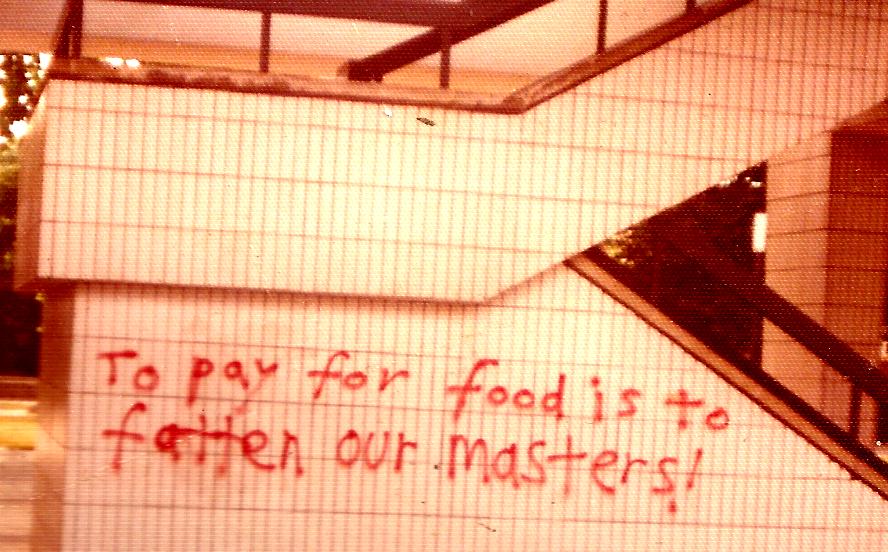 graffiti outside supermarket, 1970s
graffiti outside supermarket, 1970s
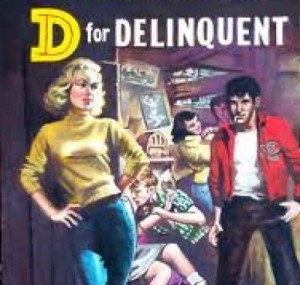
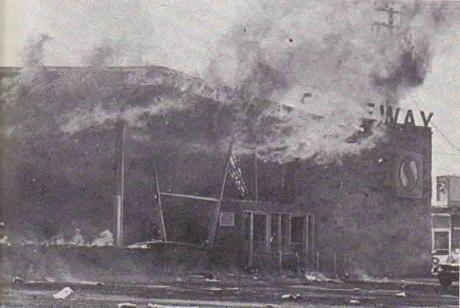
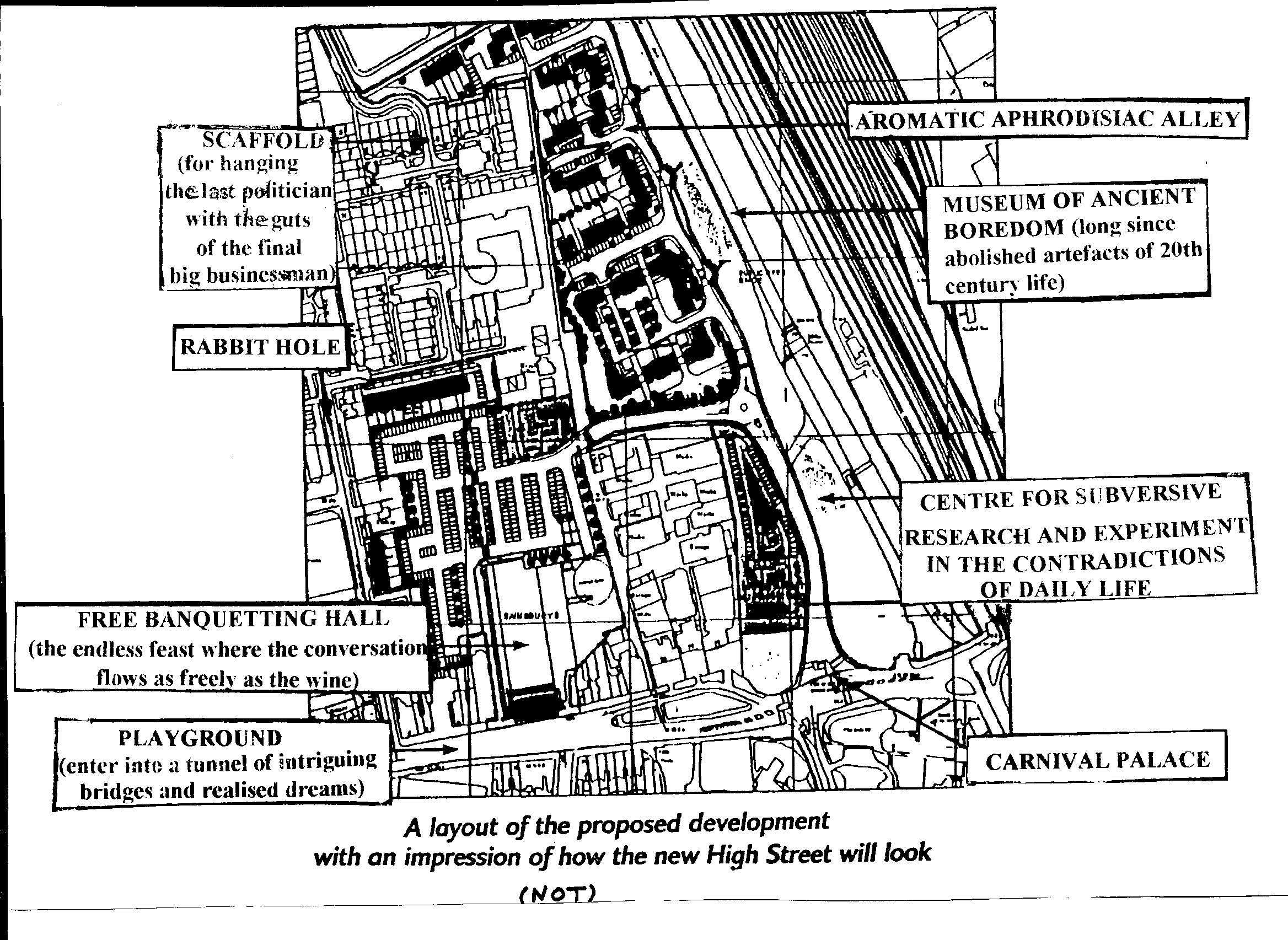
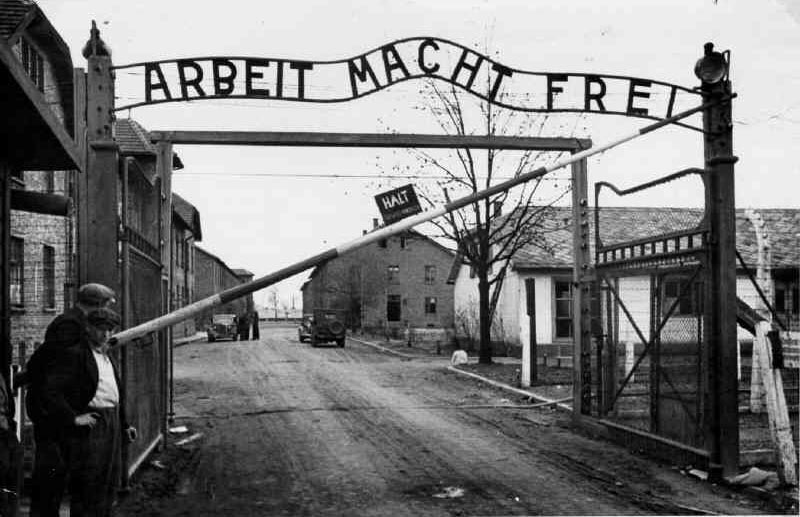
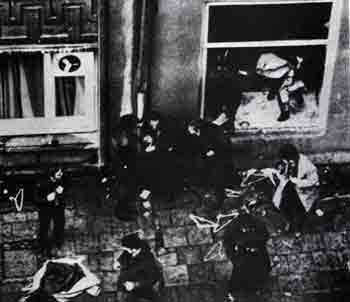
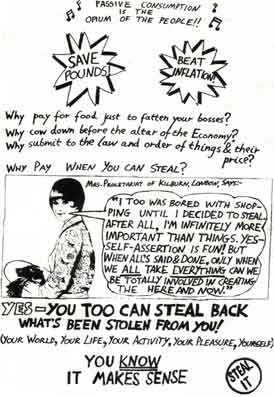
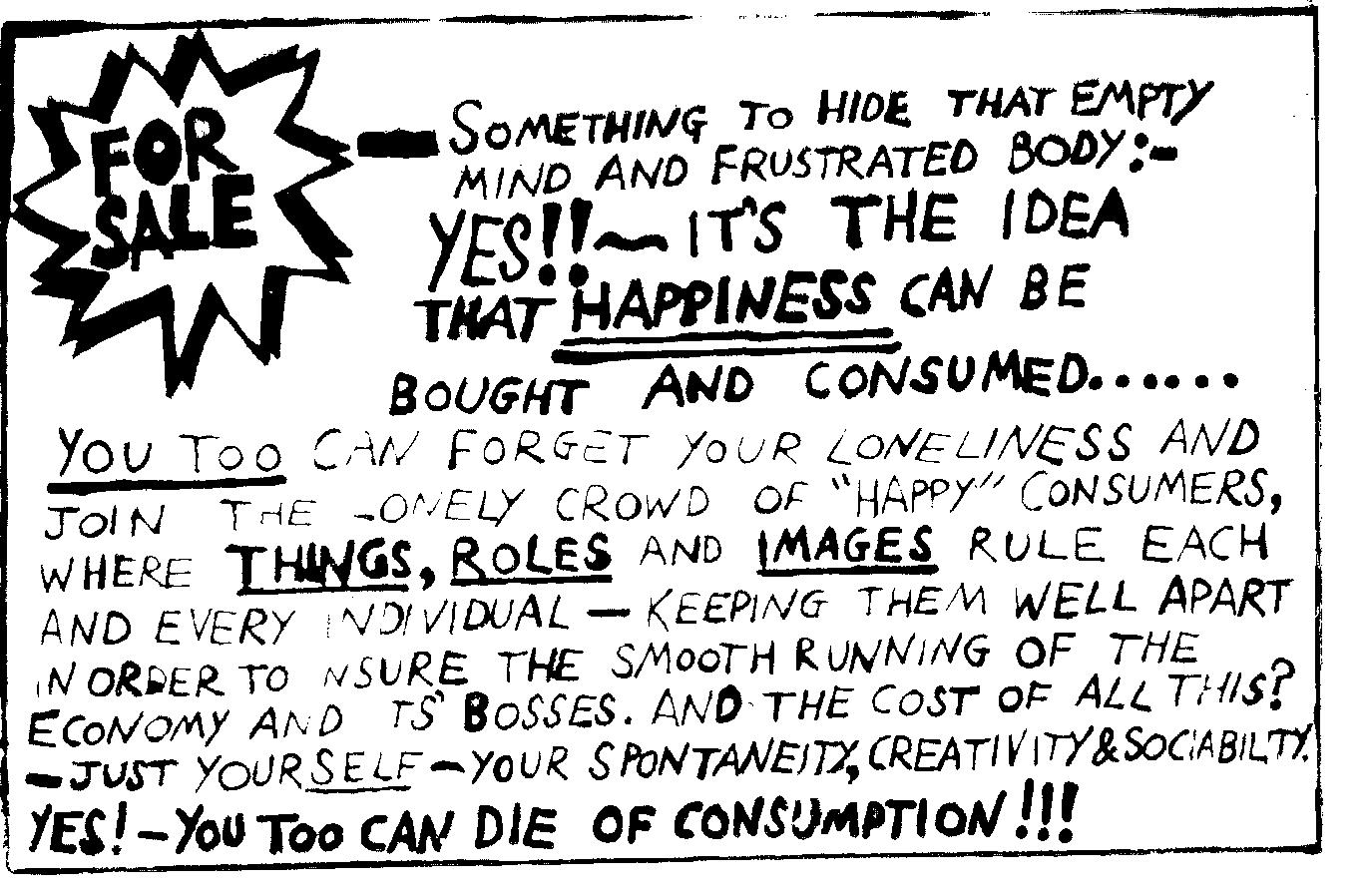
Leave a Reply